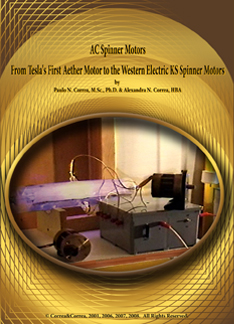![Akronos logo]](/images/akronos_wheel.jpg)
|
Akronos Publishing Concord, ON, Canada www.aetherometry.com |
![Akronos logo]](/images/akronos_wheel.jpg)
|
Akronos Publishing Concord, ON, Canada www.aetherometry.com |

The rediscovery of the ORgone motor:
(6) AC Spinner motors
by Correa, Paulo N. & Correa, Alexandra N.
Published in July 2006. 72 pages.
Experimental Aetherometry, Vol. 3
Monograph AS2-21
Price: US $35
Chapter 4 of the book The (Re-)Discovery of the Orgone Motor
|
ABSTRACT
In this communication, the Correas report the results of their investigation of the archeology of the KS spinner motors employed by Wilhelm Reich in his Orgone Motor circuit. These motors were designed by Bell Telephone Laboratories (BTL) and initially produced by Western Electric Company (WECo), both AT&T subsidiaries. These KS spinner motors are what is called eddy current motors, specifically, smooth sleeve rotor 2-phase servomotors. The history and characteristics of these servomotors, and in particular the KS-8624, KS-8988 and KS-9154 spinners, underline the critical role played by these motors in allied secret magnetron radar development during WWII, as they were employed first in the M4 and M7 gun directors developed by Sperry Corp, and subsequently in the first electronic analog computer - the M-9 gun director, designed by BTL, which was a critical element of the the SCR-584, the first pulsed microwave radar, designed by MIT's Radiation Laboratories for the US Army Signal Corps. In the immediate aftermath of WWII, these same motors continued to be employed in successive electronic analog computers that were part of radar systems employed in missile guidance, as part of the Nike Ajax program. The authors trace the origins of the spinner motors back to Tesla's first AC disc motor. Effectively, the latter is shown as having historically constituted the first version of an Aether Motor - Tesla's single-phase arrangement. It then becomes apparent how Reich's departure point for his two-phase OR Motor was Tesla's original arrangement, just as the authors' own split-phase modification took as its foundation the reconstruction of Reich's research path. |